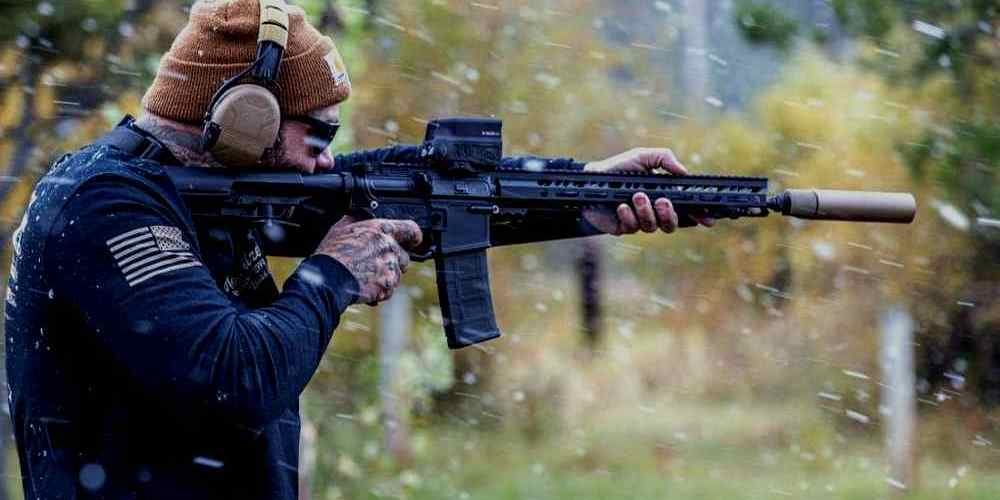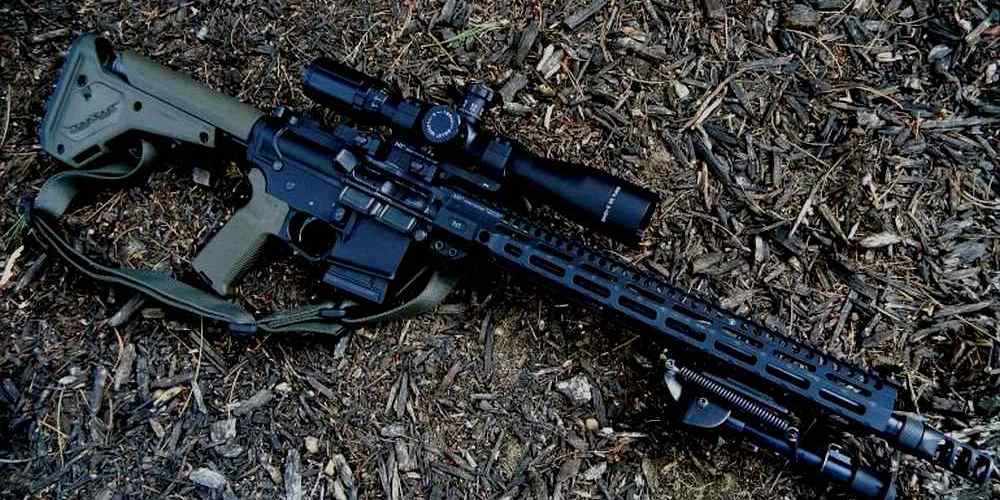“Master the muzzle rise with the science of the AR-15.”
Gas System Design and Function
The AR-15 rifle is a popular choice among gun enthusiasts for its versatility and customization options. One of the key factors that contribute to the AR-15’s accuracy and controllability is its gas system design. Understanding how the gas system works can help shooters better manage muzzle rise and improve their shooting performance.
The gas system of an AR-15 is responsible for cycling the action of the rifle, extracting and ejecting spent cartridges, and chambering a new round. The gas system consists of a gas block, gas tube, and gas key. When a round is fired, gas is tapped from the barrel and directed back towards the bolt carrier group, where it cycles the action.
The length of the gas system plays a crucial role in how the rifle functions. A longer gas system, such as a rifle-length or mid-length system, allows for a smoother and softer recoil impulse, reducing muzzle rise. On the other hand, a shorter gas system, such as a carbine-length system, can result in a sharper recoil impulse and increased muzzle rise.
The gas system design also affects the amount of gas that is directed back towards the bolt carrier group. A properly tuned gas system will deliver just enough gas to cycle the action reliably without causing excessive recoil or muzzle rise. This is achieved through the use of an adjustable gas block or by selecting the appropriate gas port size for the barrel length.
In addition to the gas system design, the weight and profile of the barrel can also impact muzzle rise. A heavier barrel will absorb more recoil energy, reducing muzzle rise and improving shot-to-shot consistency. Conversely, a lighter barrel may result in increased muzzle rise and decreased accuracy.
Another factor to consider is the muzzle device attached to the end of the barrel. Muzzle devices such as compensators and muzzle brakes are designed to redirect gases and reduce muzzle rise. Compensators feature specially designed baffles that direct gases upwards, counteracting muzzle rise. Muzzle brakes use baffles to redirect gases to the sides, reducing felt recoil and muzzle rise.
Properly tuning the gas system, selecting the right barrel profile, and choosing an appropriate muzzle device can all help reduce muzzle rise and improve shooting performance. Experimenting with different combinations of components can help shooters find the optimal setup for their specific needs and preferences.
In conclusion, the gas system design of an AR-15 plays a critical role in managing muzzle rise and improving shooting performance. By understanding how the gas system works and how different components interact, shooters can make informed decisions when customizing their rifles. With the right combination of components and proper tuning, shooters can achieve greater accuracy and control over their AR-15 rifles.

Barrel Length and Twist Rate
When it comes to shooting an AR-15, one of the most important factors to consider is muzzle rise. Muzzle rise refers to the upward movement of the barrel when a shot is fired. This can affect accuracy and control, making it crucial for shooters to understand the science behind muzzle rise and how to mitigate its effects.
One of the key factors that can influence muzzle rise is the barrel length of the AR-15. In general, longer barrels tend to have less muzzle rise compared to shorter barrels. This is because longer barrels provide more surface area for the gases produced by the burning gunpowder to act upon, which helps to counteract the upward force generated by the recoil of the firearm.
Additionally, the twist rate of the barrel can also play a role in muzzle rise. The twist rate refers to the rate at which the rifling inside the barrel twists, which affects the stability and accuracy of the bullet as it travels down the barrel. A faster twist rate can help to stabilize the bullet more effectively, reducing the amount of muzzle rise experienced when firing the AR-15.
It’s important to note that while barrel length and twist rate can influence muzzle rise, there are other factors at play as well. The weight of the firearm, the type of ammunition being used, and the shooter’s technique can all impact how much muzzle rise is experienced when firing an AR-15.
For shooters looking to reduce muzzle rise, there are a few strategies that can be employed. One option is to use a muzzle brake or compensator, which are devices that attach to the end of the barrel and redirect gases to help counteract muzzle rise. These devices can be particularly effective for shooters who are looking to improve their accuracy and control when firing their AR-15.
Another option is to practice proper shooting technique, such as maintaining a firm grip on the firearm and keeping the rifle steady during recoil. By practicing good shooting habits, shooters can help to minimize the effects of muzzle rise and improve their overall performance with the AR-15.
In conclusion, understanding the science behind AR-15 muzzle rise is essential for shooters looking to improve their accuracy and control when firing their firearm. By considering factors such as barrel length and twist rate, as well as utilizing tools like muzzle brakes and compensators, shooters can effectively reduce muzzle rise and enhance their shooting experience. With practice and attention to detail, shooters can master the art of controlling muzzle rise and become more proficient with their AR-15.
Muzzle Device Selection
The AR-15 is a popular rifle among gun enthusiasts for its versatility and customization options. One common issue that shooters face when using an AR-15 is muzzle rise. Muzzle rise occurs when the front of the rifle moves upward after firing a shot, which can affect accuracy and control. Understanding the science behind muzzle rise can help shooters select the right muzzle device to mitigate this issue.
Muzzle rise is caused by the recoil of the rifle when a round is fired. The force of the expanding gases pushing the bullet out of the barrel also pushes the rifle backward. This force creates a torque effect, causing the front of the rifle to rise. The amount of muzzle rise can vary depending on factors such as the caliber of the rifle, the weight of the rifle, and the shooter’s stance and grip.
To reduce muzzle rise, shooters can use muzzle devices such as muzzle brakes, compensators, and flash hiders. Muzzle brakes are designed to redirect the gases expelled from the barrel to reduce recoil and muzzle rise. Compensators work by redirecting the gases in a way that counteracts the upward movement of the rifle. Flash hiders are designed to reduce the visible flash created when firing a shot but can also help reduce muzzle rise to some extent.
When selecting a muzzle device, shooters should consider factors such as the type of shooting they will be doing, the caliber of their rifle, and their personal preferences. Muzzle brakes are effective at reducing recoil and muzzle rise but can increase noise and blast felt by the shooter and those around them. Compensators are also effective at reducing muzzle rise but may not be as effective at reducing recoil. Flash hiders are a good option for shooters who want to reduce muzzle rise without sacrificing the aesthetics of their rifle.
Shooters should also consider the design of the muzzle device when selecting one to reduce muzzle rise. Some muzzle devices have multiple chambers or baffles that help redirect gases in a way that reduces muzzle rise. Others have ports or slots that allow gases to escape in a controlled manner to counteract the upward movement of the rifle. Shooters should also consider the material and weight of the muzzle device, as heavier devices can help reduce muzzle rise by adding weight to the front of the rifle.
In conclusion, understanding the science behind muzzle rise can help shooters select the right muzzle device to mitigate this issue. Muzzle brakes, compensators, and flash hiders are all effective at reducing muzzle rise, but shooters should consider factors such as the type of shooting they will be doing, the caliber of their rifle, and their personal preferences when selecting a muzzle device. By choosing the right muzzle device, shooters can improve their accuracy and control when using an AR-15.
Buffer System Tuning
The AR-15 is a popular rifle platform known for its versatility and customization options. One common issue that many shooters face when using an AR-15 is muzzle rise. Muzzle rise occurs when the barrel of the rifle moves upward after firing a round, which can affect accuracy and follow-up shots. Understanding the science behind muzzle rise and how to mitigate it through buffer system tuning can help improve your shooting experience.
Muzzle rise is caused by the recoil generated when a round is fired. As the bullet travels down the barrel, it creates a force that pushes the rifle backward. This force is transferred to the shooter’s shoulder, causing the rifle to move upward. The design of the AR-15, with its direct impingement gas system, can exacerbate muzzle rise compared to other rifle platforms.
One way to reduce muzzle rise is through buffer system tuning. The buffer system in an AR-15 consists of the buffer tube, buffer spring, and buffer weight. By adjusting the weight of the buffer, you can alter the timing of the bolt carrier group’s movement, which can help reduce muzzle rise.
There are several factors to consider when tuning your buffer system. The weight of the buffer, the type of ammunition you are using, and the gas system length of your AR-15 all play a role in how the rifle recoils. A heavier buffer can help slow down the bolt carrier group’s movement, reducing the amount of force transferred to the shooter’s shoulder and mitigating muzzle rise.
When tuning your buffer system, it is important to start with a baseline configuration and make small adjustments to find the optimal setup for your rifle. Begin by testing your rifle with the factory buffer weight and spring to establish a baseline. Pay attention to how the rifle recoils and where the muzzle rises after firing a round.
If you are experiencing excessive muzzle rise, consider switching to a heavier buffer weight. A heavier buffer will increase the mass moving rearward with the bolt carrier group, which can help counteract the upward movement of the barrel. Experiment with different buffer weights to find the right balance between reducing muzzle rise and maintaining reliable cycling of the rifle.
In addition to buffer weight, the type of ammunition you are using can also impact muzzle rise. Lighter bullets and hotter loads can generate more recoil, leading to increased muzzle rise. Consider using heavier bullets or lower recoil ammunition to help reduce muzzle rise.
The gas system length of your AR-15 can also affect muzzle rise. A rifle with a shorter gas system, such as a carbine-length gas system, may experience more pronounced muzzle rise compared to a rifle with a mid-length or rifle-length gas system. If you are struggling with muzzle rise, consider switching to a longer gas system to help mitigate recoil.
Overall, buffer system tuning is a valuable tool for reducing muzzle rise in your AR-15. By adjusting the weight of the buffer and considering factors such as ammunition and gas system length, you can optimize your rifle’s performance and improve your shooting experience. Experiment with different configurations to find the setup that works best for you, and enjoy a more controlled and accurate shooting experience with your AR-15.
Recoil Management Techniques
The AR-15 is a popular rifle among gun enthusiasts for its versatility and accuracy. However, one common issue that many shooters face when using an AR-15 is muzzle rise. Muzzle rise occurs when the barrel of the rifle moves upward after firing a shot, which can affect accuracy and make it more difficult to quickly acquire a target for follow-up shots.
Understanding the science behind muzzle rise can help shooters better manage recoil and improve their shooting performance. Muzzle rise is caused by the force of the expanding gases that propel the bullet out of the barrel. When the bullet exits the barrel, the gases push against the muzzle, causing it to rise. The amount of muzzle rise can vary depending on factors such as the weight of the rifle, the caliber of the ammunition, and the shooter’s technique.
There are several techniques that shooters can use to reduce muzzle rise and improve their shooting accuracy. One effective technique is to use a muzzle brake or compensator. These devices are attached to the end of the barrel and redirect the gases to help counteract muzzle rise. Muzzle brakes are designed to reduce recoil by venting gases to the sides, while compensators are designed to reduce muzzle rise by directing gases upward.
Another technique that can help reduce muzzle rise is to use proper shooting stance and grip. A firm grip on the rifle and a stable shooting stance can help absorb some of the recoil and prevent the muzzle from rising too much. Shooters should also focus on keeping their wrists firm and their elbows slightly bent to help control the rifle’s movement.
Practicing proper breathing and trigger control can also help reduce muzzle rise. Shooters should take slow, steady breaths and squeeze the trigger gently to avoid jerking the rifle and causing the muzzle to rise. By practicing good shooting fundamentals, shooters can improve their accuracy and reduce the effects of muzzle rise.
In addition to using techniques to reduce muzzle rise, shooters can also make adjustments to their rifle to help manage recoil. Adding a heavier buffer or recoil spring can help absorb some of the recoil and reduce muzzle rise. Shooters can also experiment with different types of ammunition to find a load that produces less recoil and muzzle rise.
Overall, understanding the science behind muzzle rise and practicing proper recoil management techniques can help shooters improve their shooting performance with an AR-15. By using techniques such as using a muzzle brake, maintaining a stable shooting stance, and practicing good shooting fundamentals, shooters can reduce muzzle rise and improve their accuracy. With practice and dedication, shooters can master the art of recoil management and become more proficient with their AR-15 rifle.




